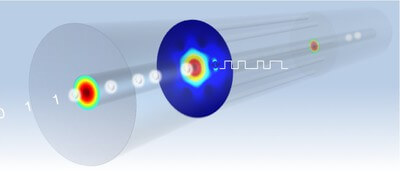The main researcher explains that one of the biggest current technological challenges is converting information between optical components and electronic components quickly and efficiently

For the first time ever, a group of chemists, physicists and engineers succeeded in developing crystalline materials that allow an optical fiber to be integrated and function in fast electronic components. The possible applications of such optical fibers include telecommunications and other improved optical/electronic technologies, improved laser technology and more accurate devices for remote sensing. The international team, led by chemistry professor John Badding from Penn State University, published its findings in the scientific journal Nature Photonics.
The main researcher explains that one of the biggest current technological challenges is converting information between optical components and electronic components quickly and efficiently. Current technology leads to rather cumbersome methods of combining optical fibers together with electronic chips - silicon-based integrated circuits that function as the building blocks for most semiconductor electronic devices such as solar cells, light-emitting diodes, computers and mobile phones.
"The optical fiber is usually a tolerant medium that simply transmits light, while the chip is the component that performs the electronic role in the system," explains the lead researcher. "For example, light is transmitted from London to New York through fiber optic cables when two people use a video call using their computers. However, the computer screens and the electronic devices related to them have to convert the received light into an image, a mechanism that is electronic. Light and electricity work in coordination in a process called OEO conversion, or optical-electrical-optical conversion." The researcher explains that ideally, instead of integrating an optical fiber inside a chip, which is a common practice in existing technologies, a "sophisticated fiber" will include the electronic functions already integrated into it.
The combination of optical fibers and chips is complicated due to several flavors. First, fibers are rounded and cylindrical, while chips are flat, so designing the connection between them is quite challenging. Another challenge is the arrangement of such tiny components. "An optical fiber is ten times smaller than the thickness of a human hair. In addition to that, there are light-directing tracks built into the chips that are even a hundred times smaller than the fibers," notes the lead researcher. "So, imagine you're just trying to arrange these two components together. This operation is a great challenge to existing technologies."
In order to deal with these challenges, the researchers used a different approach - instead of fusing a flat chip with a rounded optical fiber, the researchers found a way to build a new type of optical fiber that includes an integrated electronic component, and in this way they bypassed the need to integrate a fiber into an optical component inside a chip. To do this, they used high-pressure chemical methods to deposit semiconductor materials directly, layer by layer, into tiny holes present in optical fibers. "The big breakthrough in our research is that we did not require an entire chip as part of the finished product. We were able to build the junction - the active boundary where the electronic activity takes place - directly into the fiber," explains one of the researchers. "Furthermore, while conventional chip manufacturing requires the use of clean room facilities costing millions of dollars, our process can be performed using simple equipment that costs much less."
The researcher adds that one of the main goals of the research in this field is to create a flat system composed entirely of fibers. "If the electrical signal never leaves the fiber, then the method is much faster, cheaper and more efficient," the researcher points out. "Moving the technology from chip directly to fiber, which is the more natural environment for light, advances the potential for embedded semiconductor materials capable of advancing optoelectronic activity to the next level. At the moment, we still have to build electronic switching at both ends of the optical fiber. If we can practically create signals inside the fiber, we can reach a full range of optoelectronic applications."
The research also has many possible applications outside of telecommunications; For example, our research presents a completely different approach to the production of semiconductor junctions that will be used in research for the development of solar cell applications," explains the lead researcher.
The news about the study
